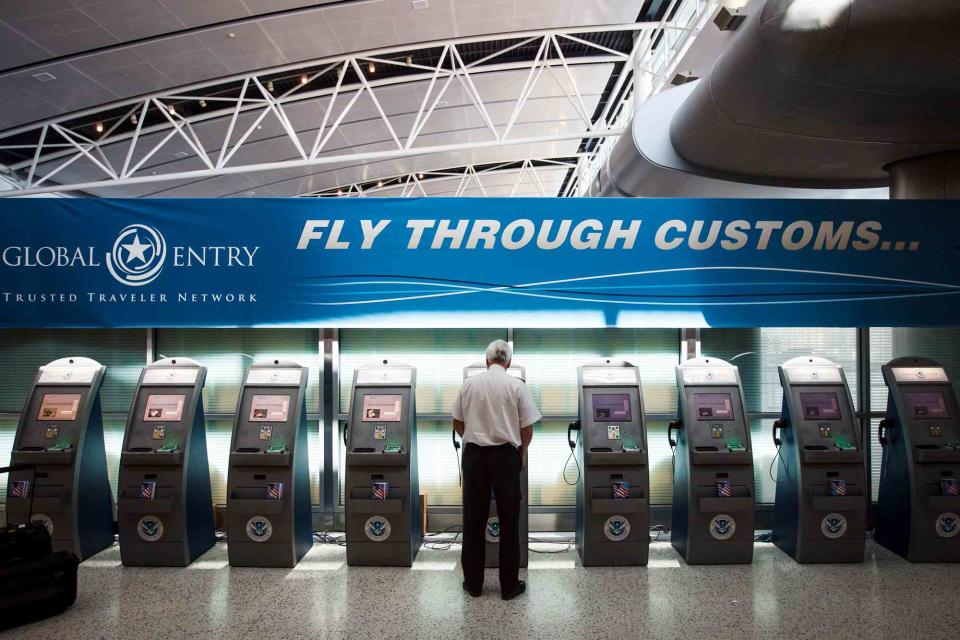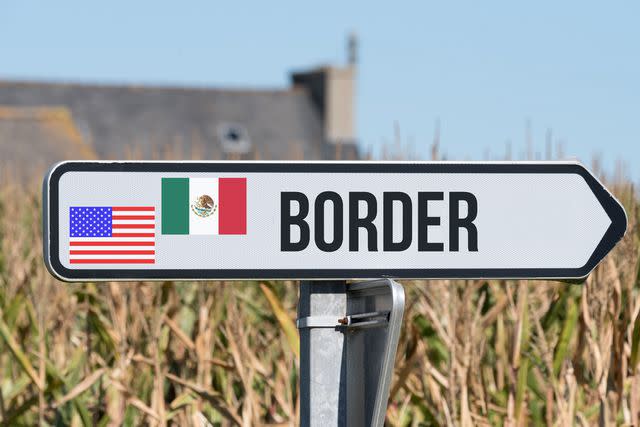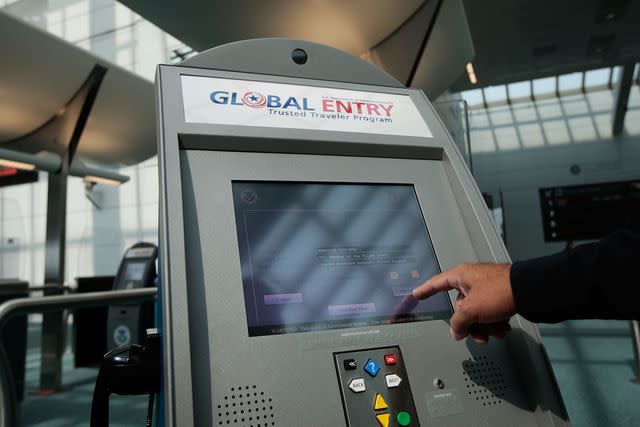Global Entry vs. SENTRI: Which One Should You Choose?
Find out which of the Trusted Traveler Programs is better for you.

Michael Paulsen/Houston Chronicle via Getty Images
When entering the United States, either as a foreign national or a U.S. citizen, wait times at the border can be excruciatingly long. If you're a frequent traveler, you can make the process move more quickly by enrolling in one of the five Trusted Traveler Programs (TTP) managed by the United States Customs and Border Protection (CBP), part of the Department of Homeland Security. These programs provide low-risk travelers a streamlined entry into the U.S.
Here, we break down the differences between two of them: Global Entry vs SENTRI. Find out which is best for you.

Stadtratte/Getty Images
What is Global Entry?
Global Entry is one of the five TTPs for expedited entry into the U.S., and it's the most powerful of the group. At most major international airports and some seaports, Global Entry members can use special kiosks to enter the country, rather than wait in the long line to be inspected by a border agent. If you're deciding between Global Entry and SENTRI, it's worth noting that Global Entry also provides access to SENTRI lanes at the U.S.–Mexico border if you register your vehicle with CBP. Global Entry memberships are valid for five years.
Who is eligible for Global Entry?
U.S. citizens and lawful permanent residents are eligible for Global Entry, as are citizens of Argentina, Brazil, Colombia, Germany, India, Israel, Japan, Mexico, Netherlands, Panama, Qatar, Republic of Korea, Saudi Arabia, Singapore, Switzerland, Taiwan, and the United Kingdom.
Related: Yes, Your Kid Needs Their Own Global Entry Membership — How to Apply

Chris Hondros/Getty Images
How can I apply for Global Entry?
Create a TTP account online, fill out an application, and pay the nonrefundable $100 fee (many travel credit cards offer an automatic credit once every five years). Once you are conditionally approved, you must schedule an interview at a Global Entry Enrollment Center, bringing with you a passport and a second form of identification, as well as your permanent resident card (if applicable). You can also do a walk-in interview upon arrival at an airport with a center, pending availability. The application processing time is four to six months at the time of publishing.
How can I get SENTRI benefits with Global Entry?
You must register your vehicle with CBP if you intend to use the SENTRI lanes at land border crossings from Mexico into the U.S. and NEXUS lanes at land border crossings from Canada into the U.S. (You cannot use Global Entry to enter Canada via NEXUS lanes.) If you register your vehicle during your initial Global Entry application, there is no application fee. But if you add a vehicle to an existing Global Entry membership, you must pay $42. You will have to schedule an appointment at a SENTRI Enrollment Center to have your vehicle inspected by CBP.
What are the pros and cons of Global Entry?
Pros
It provides expedited entry into the U.S. by air, land, and sea.
Global Entry is not limited to U.S. citizens; lawful permanent residents, as well as citizens of certain other countries, are eligible, too.
Many credit cards cover the application fee as a perk.
It includes TSA PreCheck.
Cons
Global Entry requires an in-person interview, and appointments can be difficult to get.
CPB charges an extra $42 application fee to register your vehicle for SENTRI lane access if you do so after your initial Global Entry application.

Moon Safari/Getty Images
What is SENTRI?
Secure Electronic Network for Travelers Rapid Inspection (SENTRI) is one of the five TTPs for expedited entry into the U.S. It is specifically designed for land border crossings from Mexico into the U.S. for both pedestrians and vehicles, but it can also be used to cross from Canada into the U.S. by land.
"The program offers a streamlined solution for those crossing the border, simplifying the customs process and reducing wait times upon arrival," a spokesperson for Corporate Traveler, the flagship SME division of Flight Centre Travel Group, tells Travel + Leisure. "SENTRI greatly enhances the experience for those traveling along the borders as members are not regularly subjected to normal customs and immigration questioning."
SENTRI is also beneficial to Mexican nationals who would like to apply for Global Entry. "Mexican citizens and residents cannot apply for Global Entry outright. However, it is possible to submit a SENTRI application," Riker Pasterkiewicz, a travel advisor with Fora Travel, tells T+L. "After their SENTRI application is approved, they can apply for Global Entry once they have passed a risk assessment test that the Mexican government conducts."
Who is eligible for SENTRI?
All nationalities are eligible for SENTRI, which is a key difference from Global Entry.
How can I apply for SENTRI?
Register on the TTP website, complete an application online, and pay the nonrefundable fee of $122.25. Once you are conditionally approved, you will have to schedule an interview at a SENTRI Enrollment Center. Bring with you a form of identification, a permanent resident card (if applicable), your vehicle registration, and evidence of automobile insurance valid in the U.S.
At the time of publication, SENTRI processing takes 10 to 12 months. "SENTRI often has a longer processing time because immigration tends to be much more of an issue at land borders," says the Corporate Traveler spokesperson. "There are also fewer SENTRI enrollment centers, and they are all located near the southern border."
Kristin Winkaffe Jaffe, founder of Winkaffe Global Travel, notes that the processing time is longer than Global Entry because SENTRI requires approvals by both the U.S. and Mexico. "It's a joint effort to keep things secure, so naturally, it's going to take a bit more time to get through all the hoops," she says.
How can I get Global Entry benefits with SENTRI?
If you have SENTRI and are also eligible for Global Entry (i.e., a U.S. citizen or resident, or a citizen of one of the other eligible nations), you can use the Global Entry kiosks at airports without any special registration.
What are the pros and cons of SENTRI?
Pros
It provides expedited vehicle and pedestrian entry into the U.S. from Mexico and Canada.
Any nationality is eligible for SENTRI.
It includes access to NEXUS lanes when entering the U.S. from Canada by land.
It includes access to Global Entry kiosks at airports for eligible parties.
It includes TSA PreCheck for eligible parties.
Cons
SENTRI wait times are nearly three times as long as Global Entry.
Credit cards do not cover the cost of SENTRI, which is the highest among the five TTPs.
If you're driving across the border, everyone in your car needs a SENTRI membership.
You must carry your SENTRI card with you to use the appropriate lane.
It only includes travel by air if you are eligible for Global Entry.
It does not include travel by sea.
Should I get Global Entry or SENTRI?
If you're eligible for Global Entry, it's a better choice than SENTRI. "Generally speaking, there are no use cases for U.S. residents and citizens where applying for SENTRI would benefit them over Global Entry," says Pasterkiewicz. Global Entry is cheaper than SENTRI ($100 versus $122.25), has a processing time up to twice as fast, and includes travel by air, land, and sea — including access to SENTRI lanes once your vehicle is registered.
But if you're not eligible for Global Entry, and you frequently travel between the U.S. and Mexico and/or Canada by land, SENTRI is the right program for you. Additionally, if you are a Mexican national or resident, you can use your SENTRI membership as a qualification for your Global Entry application.
The TTP website also has a helpful tool that suggests which program is best for you based on your citizenship and travel habits.
For more Travel & Leisure news, make sure to sign up for our newsletter!
Read the original article on Travel & Leisure.

